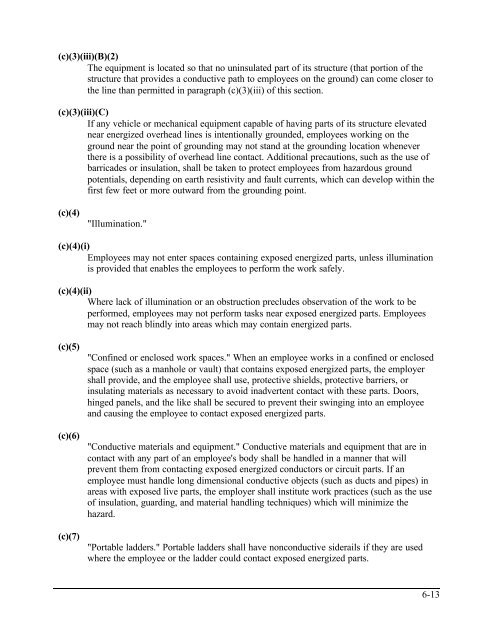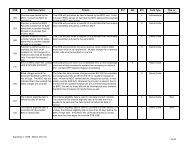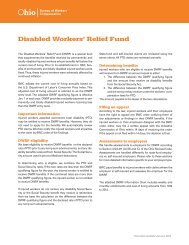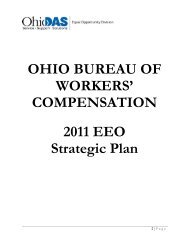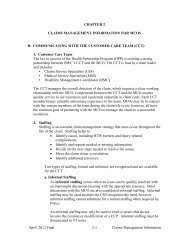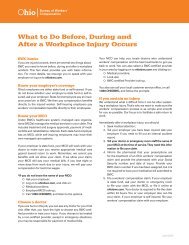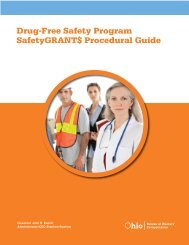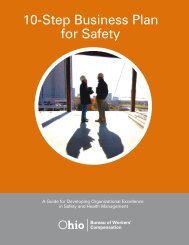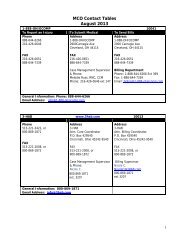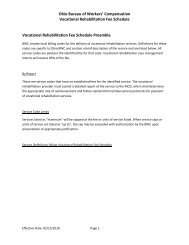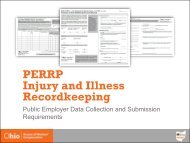Lockout / Tagout - Ohio Bureau of Workers' Compensation
Lockout / Tagout - Ohio Bureau of Workers' Compensation
Lockout / Tagout - Ohio Bureau of Workers' Compensation
You also want an ePaper? Increase the reach of your titles
YUMPU automatically turns print PDFs into web optimized ePapers that Google loves.
(c)(3)(iii)(B)(2)<br />
The equipment is located so that no uninsulated part <strong>of</strong> its structure (that portion <strong>of</strong> the<br />
structure that provides a conductive path to employees on the ground) can come closer to<br />
the line than permitted in paragraph (c)(3)(iii) <strong>of</strong> this section.<br />
(c)(3)(iii)(C)<br />
If any vehicle or mechanical equipment capable <strong>of</strong> having parts <strong>of</strong> its structure elevated<br />
near energized overhead lines is intentionally grounded, employees working on the<br />
ground near the point <strong>of</strong> grounding may not stand at the grounding location whenever<br />
there is a possibility <strong>of</strong> overhead line contact. Additional precautions, such as the use <strong>of</strong><br />
barricades or insulation, shall be taken to protect employees from hazardous ground<br />
potentials, depending on earth resistivity and fault currents, which can develop within the<br />
first few feet or more outward from the grounding point.<br />
(c)(4)<br />
"Illumination."<br />
(c)(4)(i)<br />
Employees may not enter spaces containing exposed energized parts, unless illumination<br />
is provided that enables the employees to perform the work safely.<br />
(c)(4)(ii)<br />
Where lack <strong>of</strong> illumination or an obstruction precludes observation <strong>of</strong> the work to be<br />
performed, employees may not perform tasks near exposed energized parts. Employees<br />
may not reach blindly into areas which may contain energized parts.<br />
(c)(5)<br />
(c)(6)<br />
(c)(7)<br />
"Confined or enclosed work spaces." When an employee works in a confined or enclosed<br />
space (such as a manhole or vault) that contains exposed energized parts, the employer<br />
shall provide, and the employee shall use, protective shields, protective barriers, or<br />
insulating materials as necessary to avoid inadvertent contact with these parts. Doors,<br />
hinged panels, and the like shall be secured to prevent their swinging into an employee<br />
and causing the employee to contact exposed energized parts.<br />
"Conductive materials and equipment." Conductive materials and equipment that are in<br />
contact with any part <strong>of</strong> an employee's body shall be handled in a manner that will<br />
prevent them from contacting exposed energized conductors or circuit parts. If an<br />
employee must handle long dimensional conductive objects (such as ducts and pipes) in<br />
areas with exposed live parts, the employer shall institute work practices (such as the use<br />
<strong>of</strong> insulation, guarding, and material handling techniques) which will minimize the<br />
hazard.<br />
"Portable ladders." Portable ladders shall have nonconductive siderails if they are used<br />
where the employee or the ladder could contact exposed energized parts.<br />
6-13


